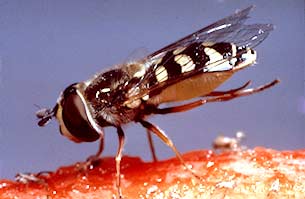Persea Mite - a frustrating pest of avocados
 |
Symptoms of Persea Mite feeding damageThe Persea Mite, Oligonychus perseae, is a pest on avocados and camphor. These mites nest along veins on the underside of the leaves. They spin a small semicircular web like a lean-to under which they feed and lay their eggs. Persea mite feeds by poking the leaf surface with its sharp, hollow-tube type of mouthparts, thus destroying the plant cells which they then suck up. These actions cause a discoloration at the feeding site, turning the spot light green, progressing to yellow, beige, brown, to almost black. These spots can be seen through the upper surface of the leaves and give the appearance some call 'measles'. As the population of the pest grows, they will start nesting in between the veins, where the spots are circular in shape. |
 |
Tracking this pest for predator release timingThe cells that have been fed on are permanently destroyed and the spots cannot be made green again by fertilizer or any other process; they remain spotted until the leaf drops from the tree. Because of this, it is useful to mark the place on the stem where the new spring leaves form, so that you will easily know the difference between the old and new leaves. When the spring flush begins, tie a peice of brightly colored yarn or flagging tape loosely around the stem between this new growth and the last year's growth. The new growth should be entirely free of spotting. As the spring and summer progress, check the new leaves for spotting typical of this pest. Since the leaves should have no spots, if you find some, you know that the Persea Mite infestation has begun. This is the best time to release the predator, Neosieulus californicus, since the pest is present (the predators must have something to eat) and still at low populations levels (so the predators won't have such a large number of pests to overcome). |
 "> "> |
To release the predator, you staple french fry bags (included) to the leaves of the tree so they are hanging from the tree. Then you pour some of the ground up corn cob material that the predators are shipped in into the bags. The predators climb out of the corn cob material and up into the tree to search for and consume the pest. Most of the predators will be out of the bag within a few hours of being placed in the bag. After 5 to 7 days you can remove the bags. This extra time allows any eggs the predators laid while in transit to hatch and join the team. The predators will take 3 - 6 weeks to bring the Persea Mite under control. You can tell that you are getting control when new flush leaves are no longer showing the spotting symptom. |

